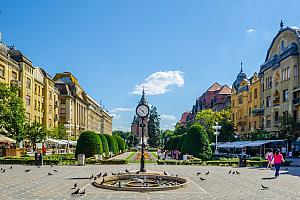Romanian cities get lower scores in 2019 Cultural and Creative Cities Monitor

The Romanian cities included in the 2019 edition of the Cultural and Creative Cities Monitor have received lower scores compared to those in the 2017 edition of the report, G4media.ro reported.
The report looks at how 190 cities in 30 European countries perform on a range of measures describing the ‘Cultural Vibrancy’, the ‘Creative Economy’ and the ‘Enabling Environment’ of a city.
Cultural Vibrancy measures a city’s cultural ‘pulse’ in terms of cultural infrastructure and participation in culture. Creative Economy captures the extent to which the cultural and creative sectors contribute to a city’s economy in terms of employment, job creation and innovation, while Enabling Environment identifies the tangible and intangible assets that help cities.
The selected cities were grouped into five categories according to their size: XXL – cities of over 1 million inhabitants; XL – cities with in between 500,000 and 1 million inhabitants; L – cities with in between 250,000 and 500,000 inhabitants; M - cities with in between 100,000 and 250,000 inhabitants; and S - cities with in between 50,000 and 100,000 inhabitants.
Bucharest was included in the XXL category, Cluj-Napoca, Timișoara and Iași in the L category, and Baia Mare and Sibiu in the M category.
In the 2019 report, Bucharest has a score of 22.8, Cluj of 20.5, Sibiu of 18.2, Timișoara of 18.1, Iași of 16.1, and Baia Mare of 14.2. In the 2017 edition of the report, Bucharest had a score of 27.8, Cluj of 25.7, Sibiu of 23.4, Timișoara of 23.3, Baia Mare of 19 and Iași of 16.9, G4media.ro reported.
Cluj-Napoca (pictured) achieved the best position in the country in relation to similar European cities, ranking 25th in the group of 40 European cities with 250,000 to 500,000 inhabitants. Timişoara, which will be a European Capital of Culture in 2021, is 31st in the same group, followed by Iași, ranked 34th.
Bucharest ranks 17th out of 20 cities in its category, while Sibiu came out 43rd out of 57 cities, and Baia Mare 55th.
On ‘Creative Economy’, Bucharest ranks 10th in its group of 20 ranked European cities with more than 1 million inhabitants, thanks to its 4th position on New Jobs in Creative Sectors. Cluj-Napoca is 9th on the same dimension in its population group.
Overall, Paris received the highest score, of 66 points, in the XXL category, followed by Munich, London and Milan. In the XL category, Copenhagen leads with a score of 46.8, followed by Lisbon and Stockholm. In the L category, Florence leads with a score of 37.6, while Lund leads in the M category, with a score of 38.9.
The 2019 scores can be checked here.
(Photo: Adobe Stock)













